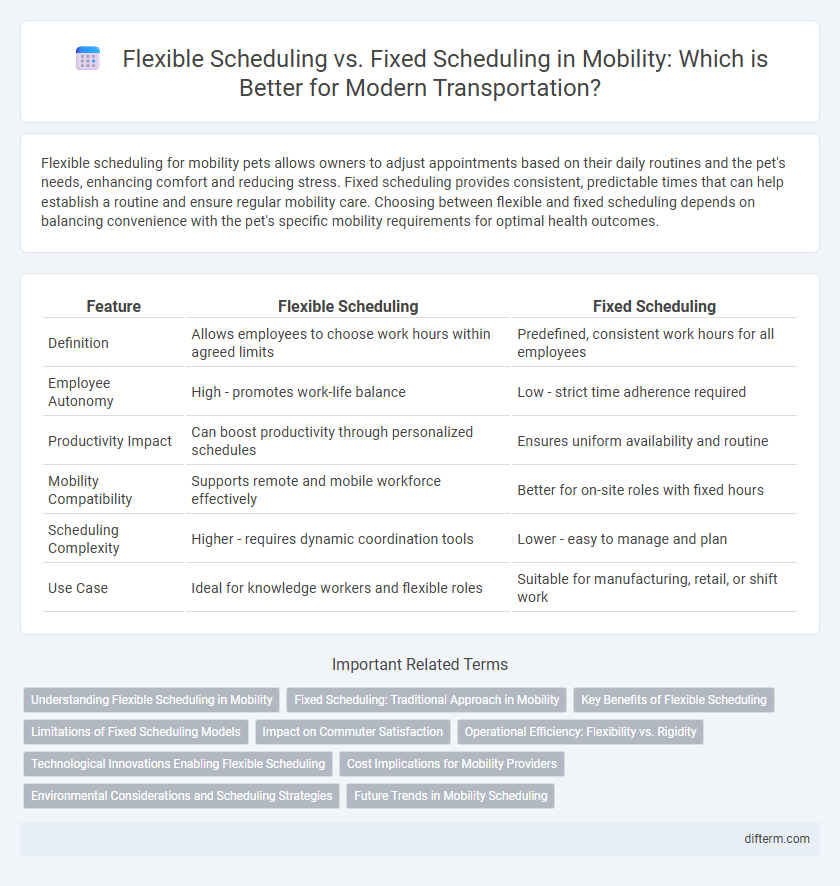Flexible scheduling for mobility pets allows owners to adjust appointments based on their daily routines and the pet's needs, enhancing comfort and reducing stress. Fixed scheduling provides consistent, predictable times that can help establish a routine and ensure regular mobility care. Choosing between flexible and fixed scheduling depends on balancing convenience with the pet's specific mobility requirements for optimal health outcomes.
Table of Comparison
| Feature | Flexible Scheduling | Fixed Scheduling |
|---|---|---|
| Definition | Allows employees to choose work hours within agreed limits | Predefined, consistent work hours for all employees |
| Employee Autonomy | High - promotes work-life balance | Low - strict time adherence required |
| Productivity Impact | Can boost productivity through personalized schedules | Ensures uniform availability and routine |
| Mobility Compatibility | Supports remote and mobile workforce effectively | Better for on-site roles with fixed hours |
| Scheduling Complexity | Higher - requires dynamic coordination tools | Lower - easy to manage and plan |
| Use Case | Ideal for knowledge workers and flexible roles | Suitable for manufacturing, retail, or shift work |
Understanding Flexible Scheduling in Mobility
Flexible scheduling in mobility allows employees to adjust their work hours based on personal needs or commuting patterns, enhancing work-life balance and reducing peak-hour traffic congestion. This approach leverages real-time data and mobile connectivity to enable seamless coordination and productivity regardless of location. Companies adopting flexible scheduling report increased employee satisfaction and decreased absenteeism, driving overall operational efficiency.
Fixed Scheduling: Traditional Approach in Mobility
Fixed scheduling in mobility relies on predetermined, consistent departure and arrival times, ensuring predictability and routine for daily commuters. This traditional approach streamlines transit operations by enabling precise resource allocation, reducing operational uncertainties and improving route adherence. Despite limitations in adaptability to real-time demand fluctuations, fixed scheduling remains essential for maintaining stable, reliable transportation networks in densely populated urban areas.
Key Benefits of Flexible Scheduling
Flexible scheduling enhances employee work-life balance by allowing varied start and end times, leading to increased productivity and reduced absenteeism. It supports diverse workforce needs, accommodating peak performance periods and personal commitments, which boosts overall job satisfaction. Businesses benefit from flexibility through improved talent retention and adaptability to fluctuating workload demands.
Limitations of Fixed Scheduling Models
Fixed scheduling models in mobility systems often fail to accommodate real-time variations in traffic flow and user demand, leading to inefficiencies and increased congestion. Their rigid structure limits adaptability, resulting in underutilized resources during off-peak hours and overcrowding during peak periods. This inflexibility hampers service optimization, reducing overall mobility effectiveness and user satisfaction.
Impact on Commuter Satisfaction
Flexible scheduling significantly enhances commuter satisfaction by reducing peak-hour congestion and allowing travelers to avoid crowded transit periods, leading to a more comfortable and efficient travel experience. In contrast, fixed scheduling often results in rigid travel times that amplify overcrowding and increase stress for commuters. Empirical studies indicate that organizations implementing flexible schedules observe higher employee morale and decreased transit-related complaints.
Operational Efficiency: Flexibility vs. Rigidity
Flexible scheduling enhances operational efficiency by allowing real-time adjustments to workforce allocation, reducing downtime and adapting to fluctuating demand in mobility services. Fixed scheduling, while providing consistency, often leads to underutilized resources and less responsiveness to sudden changes in transit patterns. Mobility providers leveraging flexible schedules optimize vehicle deployment and staff availability, resulting in improved service reliability and cost-effectiveness.
Technological Innovations Enabling Flexible Scheduling
Technological innovations such as AI-powered scheduling algorithms and real-time data analytics enable flexible scheduling by optimizing routes and adapting to dynamic demand patterns in mobility services. Mobile apps integrated with GPS and IoT sensors allow seamless communication between drivers and passengers, enhancing flexibility and reducing wait times. Cloud-based platforms facilitate instant rescheduling and resource allocation, making flexible scheduling more efficient than traditional fixed timetables.
Cost Implications for Mobility Providers
Flexible scheduling allows mobility providers to optimize fleet utilization by matching vehicle deployment with real-time demand, leading to reduced idle times and lower operational costs. Fixed scheduling often results in underutilized assets during off-peak periods, increasing maintenance expenses and limiting cost efficiency. Emphasizing dynamic allocation algorithms enhances cost savings by minimizing resource wastage and improving revenue generation per vehicle.
Environmental Considerations and Scheduling Strategies
Flexible scheduling reduces peak-hour traffic congestion and lowers vehicle emissions by allowing commuters to travel during off-peak times, enhancing overall air quality. Fixed scheduling often leads to higher energy consumption and increased pollution due to synchronized travel patterns and idling in traffic. Prioritizing adaptive scheduling strategies supports sustainable mobility goals by optimizing resource use and minimizing environmental impact.
Future Trends in Mobility Scheduling
Flexible scheduling is increasingly favored in future mobility trends due to its ability to adapt to fluctuating demand patterns and enhance resource utilization in urban transportation systems. Advanced data analytics and AI-driven algorithms enable real-time adjustments to transit schedules, improving efficiency and passenger satisfaction over traditional fixed scheduling models. Integration of on-demand mobility services with flexible scheduling supports seamless multimodal transportation, reducing congestion and promoting sustainable urban mobility.
Flexible scheduling vs Fixed scheduling Infographic

 difterm.com
difterm.com